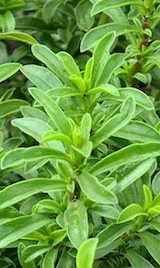 There are two kinds of savory: summer savory (Satureja hortensis) an annual, and winter savory (Satureja montana), a woody perennial. They belong to the mint family ( Lamiaceae) and are related to rosemary and thyme. Both savories are native to the Mediterranean region but have naturalized in North America. Summer savory is 1 to 1 ½ feet tall bushy, and has finely hairy stems that bear soft hairless linear leaves that are about an inch long. The leaves are gray green at first but develop purple hues by late summer or early fall. The flowers are white or pale pink and two-lipped. They are ¼ inch long and are produced in clusters of three to six from mid summer to frost. The plant is bushy, highly aromatic with a sweet scent, and has a well-branched root system. Winter savory is only six to twelve inches tall and is woody at the base. It is bushy and compact and has a heavy rather than sweet scent. The dark green leaves, are glossy, lance-shaped and about one inch long. The flowers are white or lilac, with a lower lip spotted with purple. They are one-third inch long and borne from July through mid-September in terminal spikes. Both savories do well in average, well-drained soil and full sun.
There are two kinds of savory: summer savory (Satureja hortensis) an annual, and winter savory (Satureja montana), a woody perennial. They belong to the mint family ( Lamiaceae) and are related to rosemary and thyme. Both savories are native to the Mediterranean region but have naturalized in North America. Summer savory is 1 to 1 ½ feet tall bushy, and has finely hairy stems that bear soft hairless linear leaves that are about an inch long. The leaves are gray green at first but develop purple hues by late summer or early fall. The flowers are white or pale pink and two-lipped. They are ¼ inch long and are produced in clusters of three to six from mid summer to frost. The plant is bushy, highly aromatic with a sweet scent, and has a well-branched root system. Winter savory is only six to twelve inches tall and is woody at the base. It is bushy and compact and has a heavy rather than sweet scent. The dark green leaves, are glossy, lance-shaped and about one inch long. The flowers are white or lilac, with a lower lip spotted with purple. They are one-third inch long and borne from July through mid-September in terminal spikes. Both savories do well in average, well-drained soil and full sun.
In The Winter’s Tale (act iv, sc. 4, 103) the heroine Perdita says to Polixenes, King of Bohemia, at the sheep shearing;
Here’s flowers for you;
Hot lavender, mints, savoury, marjoram;
Savory has been a culinary herb since at least ancient Roman times and both Pliny and Vergil both mention it. It was introduced into England during Caesar’s time where it was given the common name, savory, by the Anglo Saxons because of its spicy taste. The seventeenth century English botanist, Nicholas Culpepper, mentions the medicinal benefits of savory. The Italians, however, were probably the first to cultivate savory as a kitchen herb and still use it extensively in their cuisine. The genus name Satureja may have been derived from the “satyr” the half goat, half man beast of Roman mythology.